Photo collection: Arijit Chakraborty, http://www.aneyezine.com and various sources in Facebook
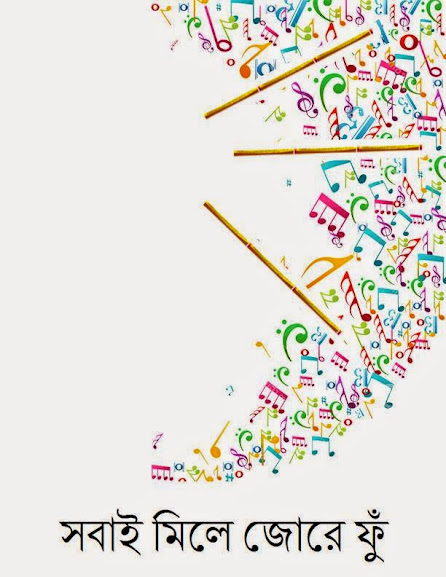
We will not repeat the chronology of events. We will not repeat what happened, and what prompted what. Because, those are verifiable, Googleable facts. Instead, we will concentrate on what cannot be so easily traced to the mere factual occurrences, but offers us with something that runs deeper. Yes, we are talking about the art that has been produced during the movement. The photographs, the signs, the graffitis, the slogans and the songs. The intimate archives of the movement. The emotional archives of the movement. What express better than any newspaper report the anger, the frustration, the inspirations of a given moment. The headiness of marching together. The dizziness of hearing one’s own voice resonating with thousands of others. This quest for something better. This quest undertaken with many, many others.
For starters, there is the slogan “Hok kolorob.” Let there be clamor. Let there be noise. Sounds. Cacophony. Chaos. Many voices. Many opinions. Many many many. But then, in the beginning, there was only Ornob. Ornob and his song, which provided the very slogan “Hok kolorob.” Yes, this is creative appropriation. But, this is also what appropriating like an artist looks like. Appropriating like an artist, stealing like an activist. Appropriating to make a song bigger than the lone singer, the lone writer. Stealing that tampers with our very ideas of property, propriety and ownership.
But then, that’s what characterizes slogans and chants.
A slogan or a chant, first of all, is a creative endeavor. It is a poetic form. A poetic form, which in the context of a social and a political movement, expresses many things: outrage, popular knowledge and socio-political analysis, desire for change. A slogan or a chant is collective in its very nature. It assumes its meanings in collective reiterations. Because it is collective and meant to express outrage, it is also anti-silence. Yes, slogans are essentially about noise, cacophony, chaos, clamor. Slogans, in order to be effective, have to be brief, pithy and attentive to meter and form. Nothing can kill the spirit of collective more than bad, sloppily put together slogans.
Most importantly, slogans are not the “creative property” of any one writer/artist. Unless one is within the day-to-day organizations of a social movement, one would not get to know who made up a particular slogan. The writer does not claim it for herself/himself. No one thinks about tracing a slogan back to its “original” writer. Its strength lies precisely in its unanimous , anonymous dissemination.
Having said that, we would also love to know how certain slogans came about amongst the hokkolorobis. The histories and the stories of the everyday of an ongoing social movement. So, if you have a story like that, please share with us. We will add them to this archive we have created.
Also, the art we have gathered here, have been collected predominantly from social media. In many cases, we are not sure who the original artist was. If you know who a piece of art can be traced back to, or you happen to be the artist yourself, please let us know. We would be more than happy to list your name here.
.






One of the main ‘counter complaints’ lodged by the university administration, as well as some of the political leaders, essentially reflected the natural discomfort, paranoia and fear of the handful in power against the vast majority of the powerless. Tending to condemn the participation of a large number of ‘outsiders’ (or more popularly known these days as the ‘Bohiragoto‘s) in this movement, who were not students of the university, or students of any sort for that matter, and therefore must have been none less than The Conspiring Cocoons, those in power attempted to dis-credit and de-legitimize the movement.
But, thanks to the collective creativity of the protestors, the word bohiragoto was made into a “new” political appellation, a political category, a site of dissent.




We cannot forgive ourselves for not having copied this brilliant piece of cartoon from the most popular temporary archive of contemporary revolution – Facebook. It came with a drawing of a Gothic Commander from The Asterix bearing the name VCgoth. The next panel showed a Gothic soldier named Ostrogoth (‘Ostro’ in the Bengali tongue translates to ‘weapon’) with a rod in his hand asking for a whom-to-kill order from the former. The last panel showed Asterix himself with a guitar strapped across his chest with the caption: Bohiragoth!
But we did manage to find this:

This indeed is the nature of this movement – using art to create its very own language of dissent. In the process, there was irreverent, courageous and seemingly effortless borrowing, stealing, appropriating. Snippets from modern Bengali poetry mixed with children’s rhymes. Sukumar Ray with Sankha Ghosh, Superman with Suman Chattopadhyay, Banksy with Shyamasangeet, Nirendranath Chakravarty with Alan Moore, Tagore with Fyataru. Thus both of these became slogans for the students:
পুলিশ দেখলে জাপটে ধরে/গান শোনাব বিশ্রী সুরে
and
বহিরাগতরা এসে ঠিক ঠিকই বুঝে নেয় কারা বহিরাগত
Is it good? Is it bad? Who cares?








Grafftits are temporary. Like slogans, they do not have one particular “author.” Graffitis redefine space. Lay claim to walls and corners and surfaces that do not really belong to the artists and protestors. States categorize most forms of graffiti-art as vandalism. We call it rethinking what belongs to whom and why. We call it creating art in unthinkable spaces. We say, vandalism precedes art. Always.








A new form of art has evolved and has received the deserved attention and popularity in the post-computer decades – digital art or Photoshop art. It can be as pithy and creative as the collective chants and slogans in a rally. The hokkolorobis and their supporters demonstrated that much!



Some of which are openly affectionate towards politicized student leaders!



Then there are the good old cartoons and doodles of the backbenchers:






There have been some powerful works of installation art on and near campus:




And, theater workers, many of them students at Jadavpur and other educational institutions, created human installations, with masks from V for Vendetta and moving tableau of chained sniffers of the state:






And, then there are the posters. With the familiar colours and tropes of protest. Re-cycling of the old forms along with the new– the raised hands, the angry fist, and the colour red.


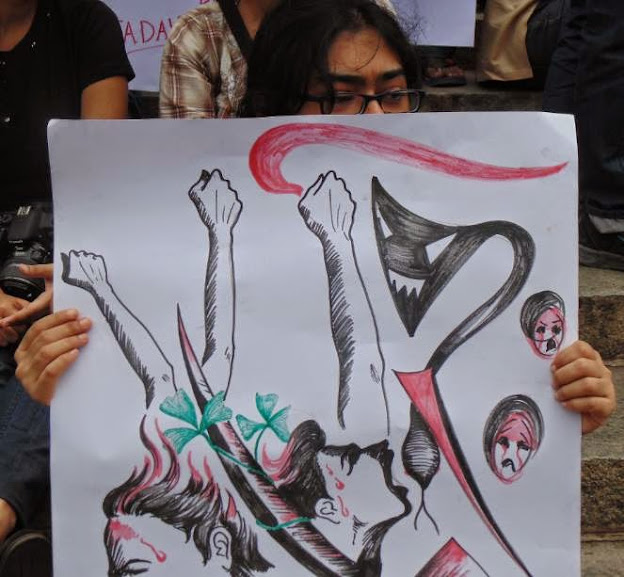





What embodies collective anger better than a poem?


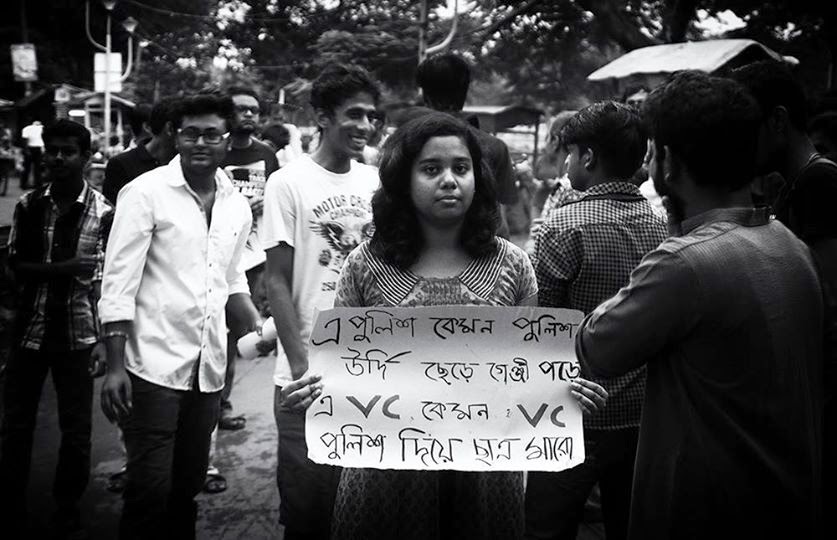


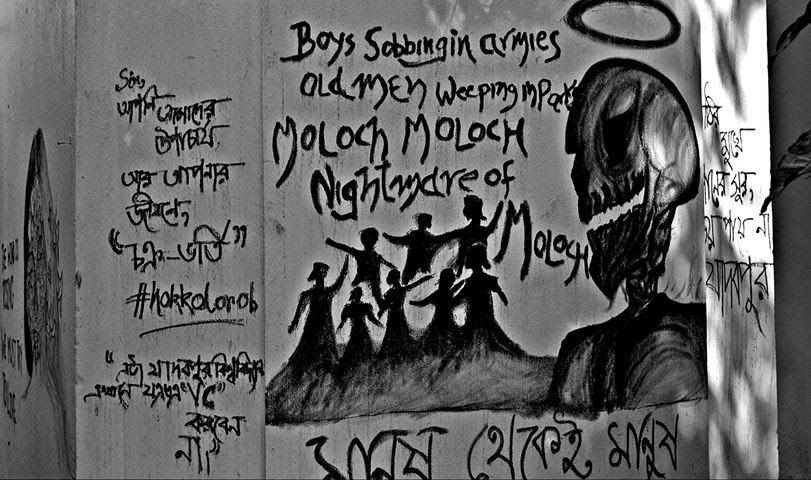
The sounds of dissent. This is what non-conformity sounds like:





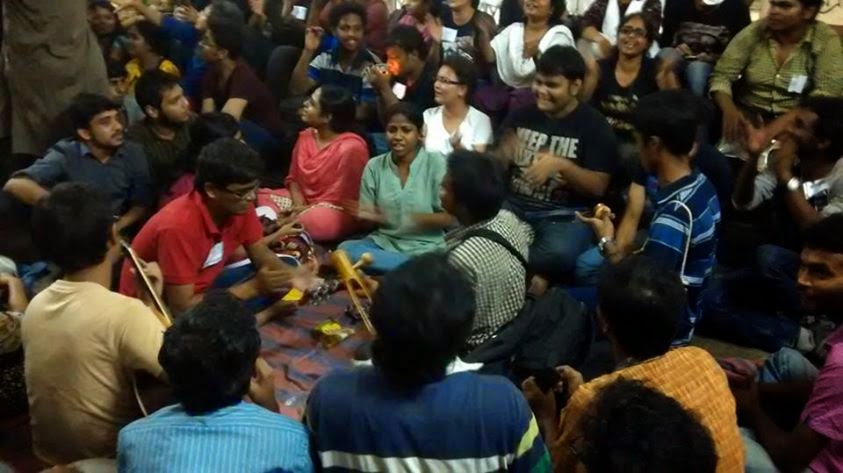
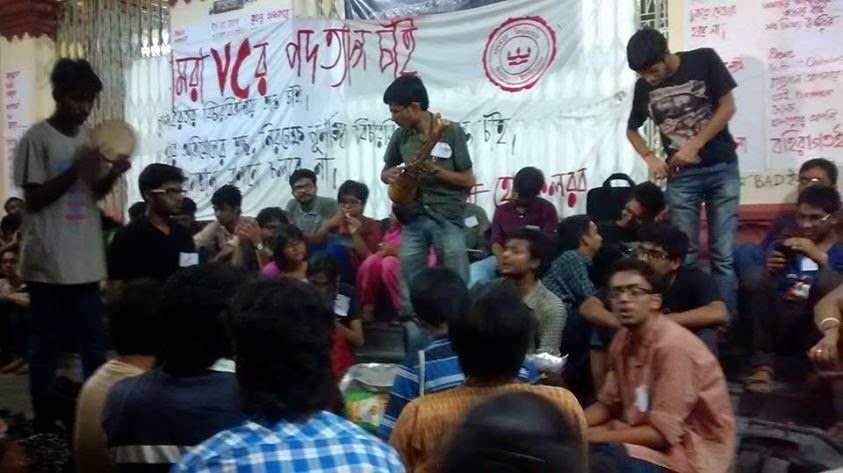
At the middle of the movement came Durgapuja which, instead of engulfing the students in passivity, inactivity and forgetfulness, itself got engulfed within the festivity of protest:
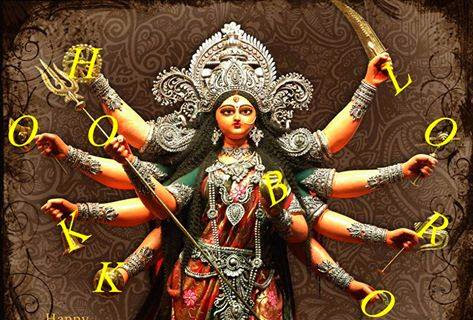


ফেসবুকের কিছু কবিতা:
১
পুলিশ কাকু … পুলিশ কাকু তোমার বাড়ি যাব।
পুলিশ কাকু তুমি কি আর আমার কথা ভাবো ?
পুলিশ কাকু সেদিন রাত-এ হঠাৎ অন্ধকারে
ছত্রভঙ্গ হয়েছিলাম তোমার ভীষণ মারে
ডেস্ক এ বসে ‘Protest’ করি , ‘অরবিন্দ ঘর’
মাত্র কজন , একশ – দুশ ‘মাওবাদী দের চর ‘
আমি তখন মহীন – ডিলান , প্রতিবাদের ভাষা
তোমরা তখন কষছিলে ছক – ভীষণ সর্বনাশা
পুলিশ কাকু …পুলিশ কাকু , বেশ তো ছিলাম ভালো
হঠাথ করে তুমি তখন নিভিয়ে দিলে আলো
তখনও আমরা ভেবেছিলাম আলোচনাই হবে
কিন্তু তুমি শান্তিপূর্ণ , কি করেছ ? কবে ?
কুঞ্জে অলি গুঞ্জে তবু , ফুটেছে মঞ্জরী
এতকিছুর পরেও তোমায় বুঝতে ভুল করি
আমি তখন হাত মিলিয়ে মানব-প্রাচীর গড়ে
‘পিশাচ’টাকে আটকেছিলাম মধ্যরাতের পরে
পুলিশ কাকু …পুলিশ কাকু , এই যে দুদিন পরে
এখনো তুমি গাইছ সাফাই , লজ্জা তোমার করে ?
সেসব কথা বলেছ তুমি , নবান্নতে গিয়ে ?
গভীর রাতে ঢুকেছিলে ভাড়াটে গুন্ডা নিয়ে
তারা সবাই ‘সিভিল ড্রেস’ এ , গায়ের রং কালো
স্বীকার করি , দুজনকেই মানিয়েছিল ভালো
ফাটিয়ে দিলে মুখ , আমার বুজিয়ে দিলে চোখ
তখনও আমরা বলেছিলাম এসব বন্ধ হোক
এরপরে যা করলে তুমি রাতের অন্ধকারে
এখনো সেসব ভাবতে কাকু … ভীষণই ভয় করে
আমার সামনে আমারই এক বান্ধবী কে মেরে
ছিড়লে জামা , মারলে ঘুষি চুলের মুঠি ধরে
রক্ত অনেক ঝরেছে , এবার ফেরত দেওয়ার পালা
লাগলে গায়ে আবার মারো , মিটিয়ে নিও জ্বালা
আজ দেখছ আমরা কেমন নেমেছিলাম পথে
হাজার হাজার ‘পলাশ’ ‘অনিল’ ‘মৌমিতা’ দের সাথে
তোমরা তখন মিছিল দেখে মুচকি মুচকি হেসে ..
ভাবছ বুঝি ‘বিপ্লব’ আর আসবে না এই দেশে
আজ মেরেছ , কাল কি হবে ? … কালের ঘরে শনি
যতই তোমায় আসকারা দিক তোমার ‘দিদিমনি’
এবার আগুন জ্বলবে কাকু , একটু পেয় ভয়
কেমন হবে , শহর যদি ‘Tien An Mien’ হয় ?
(জয় গোস্বামী বাবুর কাছে করজোড়ে ক্ষমা চেয়ে)
২
এখনো এখনো যদি
ঘরে বসে নিজেকে বাঁচাই
যদি বাধা না দিই,
তত্ত্ব করি – কী হলো কার দোষে?
যদি না আটকাই,
আজও না যদি
ঝাঁপিয়ে পড়তে পারি,
আমার সমস্ত শিল্প
আজ থেকে গণহত্যাকারী।
৩
মশালমিছিল
কাল রাতে কোনো ঘরে কোনো মা জানতে চায়নি
ছেলে তার খেয়েছে কি না,
একবারও বলেনি রেগে – এইবার যা, শুতে যা
সমস্ত দেয়াল সরে গিয়ে খোলা আকাশ,
ধিকিধিকি আলো
তারায় তারায় স্পর্ধিত পড়ছিল পা
কিছুটা ভাত ছিল ঘরে। খিদেও ছিল না
তা নয়,
তবুও জেগে ছিলাম শুধু
দূরে জাগছিল
মিছিলের হাতে হাতে দৃপ্ত প্রত্যয়
মাকে বলেছি, ওই দেখো –
দপ্দপে মুখগুলো চেনে না পরাজয়
ওদের স্লোগানে গানে গোটা দেশ প্রতিরোধগ্রাম
আমি শুধু জেগে থাকি আর
একটি দ্রোহক্ষুধা আজ সুদূর আকাশে দিলাম
নাছোড় জেদের দেশে খিদে থেকে আলো হয়
শিশুর টলোমলো পায়ে ঘোরে মশালের মুখে
সে আভায় দেখা যায় ধিক্কারধ্বনি
বাবাই দিয়েছে এঁকে কন্যাচিবুকে
কন্যা হেঁটে যায় কলরবে, আর হাঁটে রাজপথ
ক্রোধের বারুদে ঘুম ভিজে গেছে ওর
কালকে হেঁটেছ যারা মশালবাহক
জেনো – বিদ্রোহী আলোটুকু আমার জঠর
যারা ফিস্ফিস্ করে বলছে সমঝোতা,
ভাবছে স্ফুলিঙ্গ নেই,
মার খেয়ে মার খেয়ে ভাঙা, ধুধু করে তূণ
তাদের অন্ধকার মুখে হা হা হেসে কাল
মশাল বলেছে –
দেখো, পরাজয় শেখেনি আজও খিদের আগুন!
৪
হোক কলরব…
চোখে মুখে আঙুলে হাতে নখে রুক্ষ
পায়ের পদধ্বনিতে কলরব হোক নত হও,রক্তরাত
নতজানু হও- এ আমার সাম্রাজ্য এ আমার আগুন
আকাশ সাগরের গান বুকে নিয়ে উন্মাতাল
অধীর
এতো মুখরতা নিয়ে আমি এসেছি আমি হাঁটছি আমি থাকবো তবু
এই বিনিদ্র চোখে নিদ্রার
প্রতিশ্রুতি বুকে যাদবপুর থেকে তাবত
মানচিত্রে পত্র মিত্র গান প্রজাপতির
আগ্নেয়াস্ত্র হাতে অনন্ত কাল এ পথ আমার।
৬
হোক কলরব বেসুরে গান
আমরা যারা যাদবপুরে গান ধরেছি উল্টো সুরে
আমরা যারা রঙিন ধুলো অশ্বমেধের ঘোড়ার খুরে
আমরা যারা অন্ধকারে জ্বালিয়ে রাখি স্লোগান-আলো
সব স্বাভাবিক রাজ্যপাটে আমরা সবাই কেমনতর
আমরা যারা স্রোতবিরূদ্ধ রাজ্য যখন পালটে যাওয়া
জাত অভাগায় আগুন জ্বালি পাক খেয়ে যায় স্তব্ধ হাওয়া
হোক কলরব জগত যখন পথের মোড়ে একঘেয়ে গান
সব স্থীতিশীল রাজ্যপাটে আমরা সবাই উথালপাথাল
আমরা যারা জাতবেয়াদব দেখছো যখন বক্রচোখে
আমরা সবাই সেটাই হলাম মন্দ যাদের বলবে লোকে
আমরা বলি উল্টো তোমার ঠিক-বেঠিকের মাপের কাঠি
সব ঠিকেদার রাজ্যপাটে আমরা সবার দাঁতকপাটি
আমরা তখন জাতবেহায়া পোশাক যখন ইচ্ছেমতন
তোমরা তখন দর্জিসমন, দৃষ্টি হানে জবরদখল
আমরা এখন ফোটাচ্ছি খই তোমরা যখন বাক্যহারা
সব সেলামত রাজ্যপাটে আমরা ভীষণ লক্ষীছাড়া
আমরা যারা বাপ তাড়ানো ‘জয় মা’ বলে ভাসিয়ে তরী
সাগর পাড়ি দেবোই দেবো তোমরা তখন তড়িঘড়ি
তুললে দেয়াল ভাঙলে দু’ঠ্যাং চোখ রাঙালে রক্তজবা
সব শিকলের রাজ্যপাটে মন আমাদের মেললো পাখা
আমরা এখন মেঘের মতন বিশ্বজুড়ে উল্টো সুরে
নতুন আলোয় গা ভিজিয়ে খবর দেবো যাদবপুরের
হোক কলরব জগত যখন এক একটা দিন খুব বেরঙিন
নীলচে-সাদা রাজ্যপাটে রঙ এনেছি আমরা অচিন
Some brand new slogans – reverberated all over the rallies and the meetings:
তুমি ঘোঁট বাঁধো, আমরা জোট বাঁধি
লাঠির মুখে তুলির টান/পুলিশ VC নিপাত যান
and of course the most successful one which probably also shows in a way how deep the concept of buying and selling have infiltrated our minds, for a good cause in this context:
এই ভিসিকে চিনে নাও/ ওএলএক্সে বেচে দাও
as against the more traditional:
এই ভিসিকে চিনে নাও/ এই মাটিতে কবর দাও
Even as we celebrate the hok kolorobis in all their multiplicities and complexities, we worry. Our concerns are much like those who have been compelled to maintain the roles of “distant” observers because of life circumstances. Because, we do not live in Kolkata anymore. We worry about the fact that this was a movement that was spearheaded by an instance of sexual violence on campus, and students demanding a just investigation into that case in accordance to the Visakha Guidelines. Is that “original” cause now somewhat lost?
We are exhilerated by the fact that this movement has succeeded to involve women students in a way the previous generations have failed. We have witnessed, albeit from a distance,how in the last few months, the voices of the young women have resounded through the streets of Kolkata. And, along with the protestors, we are celebrating that. Yet, we have not heard the voice of that young woman whose complaint made it possible for all of this kolorob to happen in the first place. We have not seen her in any of the rallies. She is still being represented by her father, her family. She still remains the unheard, unnamed entity amongst all this noise.
In solidarity,
The co-editors of Aainanagar

0 thoughts on “#HokKolorob – A Compilation: Where Art Becomes The Language of Protest”